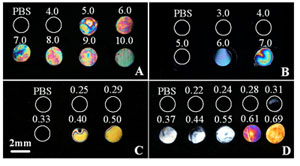629d Dark-to-Bright Optical Responses of Liquid Crystals Triggered by Proteins Absorbed on Solid Surfaces
Protein assays are critical analytical tools performed in various biochemical laboratories to quantify the concentration of proteins. In this study, we report the optical responses of a thin layer of liquid crystals supported on glass slides decorated with proteins and the utility of this phenomenon as a new “all-or-nothing” type of protein assay. It was found that the orientations of liquid crystals are very sensitive to the concentration of protein solution applied to the surface. When the protein concentration exceeds a critical value (A: IgG 5.0 μg/mL, B: BSA 6.0 μg /mL, C: FTIC-anti-biotin 0.40 μg/mL, and D: FITC-anti-IgG 0.37 μg/mL), the thin layer of liquid crystals gives a very sharp dark-to-bright optical response within a small concentration range. This characteristic is not observed in any traditional protein assays, which are based on the adsorption of UV or visible light. The optical response is also very precise and reproducible. It is not affected by the thickness of the liquid crystal cell or the amount of organosilanes coated on the glass slides. The liquid crystal-based protein assay may be very useful for screening purposes, especially when a simple positive or negative answer is desired.
